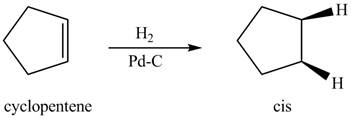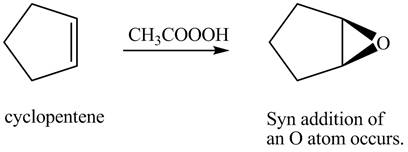
Draw the organic products formed when cyclopentene is treated with each reagent. With some
reagents, no reaction occurs.
a.
b.
c.
d.
e.
f.
g.
h.
i.
j.
k.
l. Product in (k);
(a)
Interpretation: The organic product formed when cyclopentene is treated with
Concept introduction: The addition of
Answer to Problem 12.38P
The organic product formed when cyclopentene
Explanation of Solution
In the given reaction, when cyclopentene is treated with

Figure 1
The organic product formed when cyclopentene
(b)
Interpretation: The organic product formed when cyclopentene is treated with Lindlar catalyst is to be predicted.
Concept introduction: The addition of
Answer to Problem 12.38P
Cyclopentene do not react with Lindlar catalyst.
Explanation of Solution
Alkenes do not react with Lindlar catalyst. Lindlar catalyst is used to reduce alkynes to
Cyclopentene do not react with Lindlar catalyst.
(c)
Interpretation: The product formed when the cyclopentene is treated with
Concept introduction: In presence of sodium metal in ammonia, the is alkyne is reduced to
Answer to Problem 12.38P
Cyclopentene do not react with
Explanation of Solution
Alkenes do not react with
Cyclopentene do not react with
(d)
Interpretation: The product formed when cyclopentene is treated with
Concept introduction: In presence of peroxide, alkene is oxidized to epoxide. This is known as epoxidation. This is a syn addition. The weak pi bond of alkene and weak
Answer to Problem 12.38P
The product formed when cyclopentene is treated with
Explanation of Solution
In the given reaction, when cyclopentene is treated with

Figure 2
The product formed when cyclopentene is treated with
(e)
Interpretation: The product formed when cyclopentene is treated with
Concept introduction: Anti-dihroxylation takes place in two steps epoxidation followed by hydrolysis. In presence of peroxide, alkene is oxidized to epoxide. This is known as epoxidation. This is a syn addition. The weak pi bond of alkene and weak
Answer to Problem 12.38P
The product formed when cyclopentene is treated with
Explanation of Solution
In the given reaction, when cyclopentene is treated with

Figure 3
The product formed when cyclopentene is treated with
(f)
Interpretation: The product formed when cyclopentene is treated with
Concept introduction: Addition of two hydroxyl groups on double bond to form
Answer to Problem 12.38P
The product formed when cyclopentene is treated with
Explanation of Solution
In the given reaction, when cyclopentene is treated with

Figure 4
The product formed when cyclopentene is treated with
(g)
Interpretation: The product formed when cyclopentene is treated with
Concept introduction: Addition of two hydroxyl groups on double bond to form
Answer to Problem 12.38P
The product formed when cyclopentene is treated with
Explanation of Solution
In the given reaction, when cyclopentene is treated with

Figure 5
The product formed when cyclopentene is treated with
(h)
Interpretation: The product formed when cyclopentene is treated with
Concept introduction: The metal hydride reagents are good reducing agents such as
Answer to Problem 12.38P
Cyclopentene gives no reaction with
Explanation of Solution
The
Cyclopentene gives no reaction with
(i)
Interpretation: The product formed when cyclopentene is treated with
Concept introduction: In presence of ozone and
Answer to Problem 12.38P
The product formed when cyclopentene is treated with
Explanation of Solution
In the given reaction, when cyclopentene is treated with

Figure 6
The product formed when cyclopentene is treated with
(j)
Interpretation: The product formed when cyclopentene is treated with
Concept introduction: Sharpless epoxidation involves the oxidation of double bond between carbon atoms to epoxide. This oxidation occurs only in allylic alcohol. This is an enantioselective oxidation, which means predominantly one enantiomer is formed. Sharpless reagents are
Answer to Problem 12.38P
The product formed when cyclopenteneis treated with
Explanation of Solution
There are two different chiral diethyl tartrate isomers,
When epoxidation is done using

Figure 7
The product formed when cyclopenteneis treated with
(k)
Interpretation: The product formed when cyclopentene is treated with
Concept introduction: In presence of peroxide alkene is oxidized to epoxide this is known as epoxidation. This is a syn addition. The weak pi bond of alkene and weak
Answer to Problem 12.38P
The product formed when cyclopentene is treated with
Explanation of Solution
In the given reaction, when cyclopentene is treated with

Figure 8
The product formed when cyclopentene is treated with
(l)
Interpretation: The product formed when cyclopentene is treated with
Concept introduction: In presence of peroxide, alkene is oxidized to epoxide this is known as epoxidation. This is a syn addition. The weak pi bond of alkene and weak
Answer to Problem 12.38P
The product formed when cyclopentene is treated with
Explanation of Solution
In the given reaction, when cyclopentene is treated with

Figure 9
The product formed when cyclopentene is treated with
Want to see more full solutions like this?
Chapter 12 Solutions
Package: Loose Leaf for Organic Chemistry with Biological Topics with Connect Access Card
Additional Science Textbook Solutions
Campbell Essential Biology (7th Edition)
Brock Biology of Microorganisms (15th Edition)
Microbiology Fundamentals: A Clinical Approach
Human Physiology: An Integrated Approach (8th Edition)
Human Biology: Concepts and Current Issues (8th Edition)
- PLEASE ANSWER ALL PARTS!!arrow_forwardd) Determine the formal charge on the nitrogen atom in each of the structures. NH3 NH2 N C бобкат : N N H H Н H2N-OH A B C D E F Garrow_forwardLewis Structure, Hybridization & Molecular Geometry a) Draw the Lewis Structure of the molecules; Label the hybridization of each carbon atom; Predict the approximate molecular geometry around each carbon atom. CH3CHO CH3CN b) Draw the Lewis Structure of Nitromethane; Predict the approximate molecular geometry around the nitrogen atom. CH3NO2 c) Draw the Lewis Structure; Label the hybridization of the boron atom; Predict the approximate molecular geometry. BF3 BF4arrow_forward
- a. The structure of the bicarbonate (hydrogen carbonate) ion, HCO3-, HCO3 " is best described as a hybrid of several contributing resonance forms, two of which are shown here. HO :0: HO + :Ö: Bicarbonate is crucial for the control of body pH (for example, blood pH 7.4). A more self-indulgent use is in baking soda, where it serves as a source of CO2 CO2 gas, which gives bread and pastry their fluffy constituency. (i) Draw at least one additional resonance form. = (ii) Using curved "electron-pushing" arrows, show how these Lewis structures may be interconverted by movement of electron pairs. (iii) Determine which form or forms will be the major contributor(s) to the real structure of bicarbonate, explaining your answer on the basis of the criteria in Section 1-5.arrow_forwardCalibri 11 + BIL NAME: Jaylena M A student is investigating the ctect of volume on pressure during a lab activity. The student uses the following volumes (mL). 12, 13, 14, 16, 17, 18, 19, 20, 21, 22, 23, 24, 26, 28, 30, 33, 34, 35, 38, 40, 42, 44. 46, and 50. As the volume changed they measured the following pressures (atm) 11.0, 10.5, 10.0, 9.2. 8.5, 78, 75, 7.0, 6.8, 6.5, 6.0, 5.9, 5.5, 5.0, 4.8, 4.5, 4.2, 3.9, 3.8, 3.5, 3.3, 3.2, 3.0, 2.9. What is the independent variable? Volume Imla What is the dependent variable? Pressure Jatm Use the data and make a PROPER data table. Volume 1mL) Pressure latm 110arrow_forwardDraw all resonance forms of the molecules. Include curved arrow notation. Label major resonance contributor.arrow_forward
- : Resonance Forms a) Draw all resonance forms of the molecules. Include curved arrow notation. Label major resonance contributor. SO₂ NO3arrow_forward1d. Use Le Chatelier's principle to describe the effect of the following changes on the position of the Haber-Bosch equilibrium: N2(g) + 3H2(g)= 2NH3(9) AH = -92kJ Choose one of the following answers: shift to reactant side, shift to product side or no change and draw the resulting graph. I. Increase the [N2(g)] Effect: H₂ N₂ NH3 II. Decrease the volume of the container. Effect: H₂ N₂2 NH3arrow_forwardf) The unusual molecule [2.2.2] propellane is pictured. 1) Given the bond length and bond angles in the image, what hybridization scheme best describes the carbons marked by the askerisks? 2) What types of orbitals are used in the bond between the two carbons marked by the askerisks? 3) How does this bond compare to an ordinary carbon-carbon bond (which is usually 1.54 Å long)? CH2 1.60Å H₂C * H₂C CH2 C H2C * C Of H₂ 120°arrow_forward
 ChemistryChemistryISBN:9781305957404Author:Steven S. Zumdahl, Susan A. Zumdahl, Donald J. DeCostePublisher:Cengage Learning
ChemistryChemistryISBN:9781305957404Author:Steven S. Zumdahl, Susan A. Zumdahl, Donald J. DeCostePublisher:Cengage Learning ChemistryChemistryISBN:9781259911156Author:Raymond Chang Dr., Jason Overby ProfessorPublisher:McGraw-Hill Education
ChemistryChemistryISBN:9781259911156Author:Raymond Chang Dr., Jason Overby ProfessorPublisher:McGraw-Hill Education Principles of Instrumental AnalysisChemistryISBN:9781305577213Author:Douglas A. Skoog, F. James Holler, Stanley R. CrouchPublisher:Cengage Learning
Principles of Instrumental AnalysisChemistryISBN:9781305577213Author:Douglas A. Skoog, F. James Holler, Stanley R. CrouchPublisher:Cengage Learning Organic ChemistryChemistryISBN:9780078021558Author:Janice Gorzynski Smith Dr.Publisher:McGraw-Hill Education
Organic ChemistryChemistryISBN:9780078021558Author:Janice Gorzynski Smith Dr.Publisher:McGraw-Hill Education Chemistry: Principles and ReactionsChemistryISBN:9781305079373Author:William L. Masterton, Cecile N. HurleyPublisher:Cengage Learning
Chemistry: Principles and ReactionsChemistryISBN:9781305079373Author:William L. Masterton, Cecile N. HurleyPublisher:Cengage Learning Elementary Principles of Chemical Processes, Bind...ChemistryISBN:9781118431221Author:Richard M. Felder, Ronald W. Rousseau, Lisa G. BullardPublisher:WILEY
Elementary Principles of Chemical Processes, Bind...ChemistryISBN:9781118431221Author:Richard M. Felder, Ronald W. Rousseau, Lisa G. BullardPublisher:WILEY





